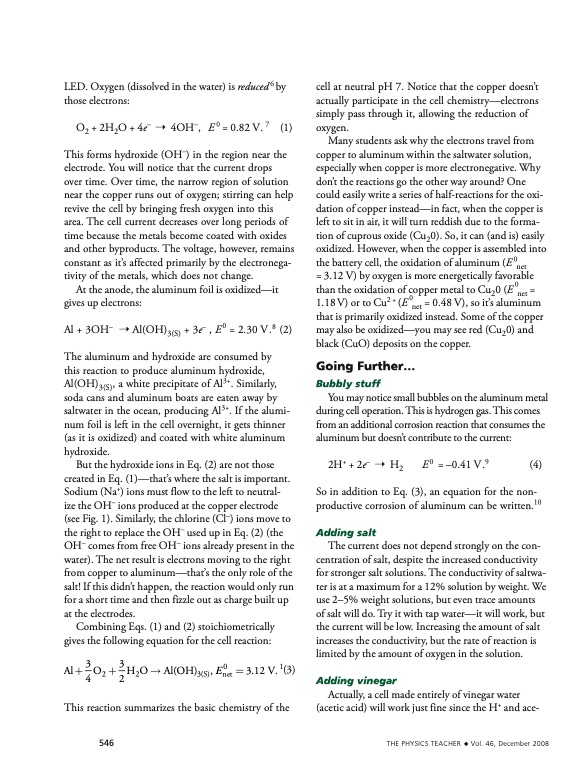
PDF Publication Title:
Text from PDF Page: 003
cell at neutral pH 7. Notice that the copper doesn’t actually participate in the cell chemistry—electrons simply pass through it, allowing the reduction of oxygen. Many students ask why the electrons travel from copper to aluminum within the saltwater solution, especially when copper is more electronegative. Why don’t the reactions go the other way around? One could easily write a series of half-reactions for the oxi- dation of copper instead—in fact, when the copper is left to sit in air, it will turn reddish due to the forma- tion of cuprous oxide (Cu20). So, it can (and is) easily oxidized. However, when the copper is assembled into the battery cell, the oxidation of aluminum (E 0net = 3.12 V) by oxygen is more energetically favorable than the oxidation of copper metal to Cu20 (E 0net = 1.18 V) or to Cu2 + (E 0net = 0.48 V), so it’s aluminum that is primarily oxidized instead. Some of the copper may also be oxidized—you may see red (Cu20) and black (CuO) deposits on the copper. Going Further... Bubbly stuff You may notice small bubbles on the aluminum metal during cell operation. This is hydrogen gas. This comes from an additional corrosion reaction that consumes the aluminum but doesn’t contribute to the current: 2H++2e– �H2 E0 =–0.41V.9 (4) So in addition to Eq. (3), an equation for the non- productive corrosion of aluminum can be written.10 Adding salt The current does not depend strongly on the con- centration of salt, despite the increased conductivity for stronger salt solutions. The conductivity of saltwa- ter is at a maximum for a 12% solution by weight. We use 2–5% weight solutions, but even trace amounts of salt will do. Try it with tap water—it will work, but the current will be low. Increasing the amount of salt increases the conductivity, but the rate of reaction is limited by the amount of oxygen in the solution. Adding vinegar Actually, a cell made entirely of vinegar water (acetic acid) will work just fine since the H+ and ace- LED. Oxygen (dissolved in the water) is reduced 6 by those electrons: O2 +2H2O+4e– � 4OH–, E0 =0.82V.7 (1) This forms hydroxide (OH–) in the region near the electrode. You will notice that the current drops over time. Over time, the narrow region of solution near the copper runs out of oxygen; stirring can help revive the cell by bringing fresh oxygen into this area. The cell current decreases over long periods of time because the metals become coated with oxides and other byproducts. The voltage, however, remains constant as it’s affected primarily by the electronega- tivity of the metals, which does not change. At the anode, the aluminum foil is oxidized—it gives up electrons: Al + 3OH– � Al(OH)3(S) + 3e– , E0 = 2.30 V.8 (2) The aluminum and hydroxide are consumed by this reaction to produce aluminum hydroxide, Al(OH)3(S), a white precipitate of Al3+. Similarly, soda cans and aluminum boats are eaten away by saltwater in the ocean, producing Al3+. If the alumi- num foil is left in the cell overnight, it gets thinner (as it is oxidized) and coated with white aluminum hydroxide. But the hydroxide ions in Eq. (2) are not those created in Eq. (1)—that’s where the salt is important. Sodium (Na+) ions must flow to the left to neutral- ize the OH– ions produced at the copper electrode (see Fig. 1). Similarly, the chlorine (Cl–) ions move to the right to replace the OH– used up in Eq. (2) (the OH– comes from free OH– ions already present in the water). The net result is electrons moving to the right from copper to aluminum—that’s the only role of the salt! If this didn’t happen, the reaction would only run for a short time and then fizzle out as charge built up at the electrodes. Combining Eqs. (1) and (2) stoichiometrically gives the following equation for the cell reaction: Al�3O �3H O�Al(OH) ,E0 �3.12V.1(3) 4 2 2 2 3(S) net This reaction summarizes the basic chemistry of the 546 THE PHYSICS TEACHER � Vol. 46, December 2008PDF Image | Salty Science of the Aluminum-Air Battery

PDF Search Title:
Salty Science of the Aluminum-Air BatteryOriginal File Name Searched:
TPT_Salty_Science.pdfDIY PDF Search: Google It | Yahoo | Bing
Product and Development Focus for Salgenx
Redox Flow Battery Technology: With the advent of the new USA tax credits for producing and selling batteries ($35/kW) we are focussing on a simple flow battery using shipping containers as the modular electrolyte storage units with tax credits up to $140,000 per system. Our main focus is on the salt battery. This battery can be used for both thermal and electrical storage applications. We call it the Cogeneration Battery or Cogen Battery. One project is converting salt (brine) based water conditioners to simultaneously produce power. In addition, there are many opportunities to extract Lithium from brine (salt lakes, groundwater, and producer water).Salt water or brine are huge sources for lithium. Most of the worlds lithium is acquired from a brine source. It's even in seawater in a low concentration. Brine is also a byproduct of huge powerplants, which can now use that as an electrolyte and a huge flow battery (which allows storage at the source).We welcome any business and equipment inquiries, as well as licensing our flow battery manufacturing.| CONTACT TEL: 608-238-6001 Email: greg@salgenx.com | RSS | AMP |